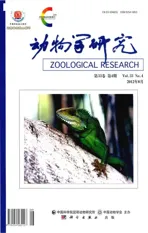Description of a new record species of Heterodera from China(Tylenchida, Heteroderidae)
2012-12-25DongWANGLijieCHENYuxiDUAN
Dong WANG, Lijie CHEN, Yuxi DUAN
Nematology Institute of Northern China, Shenyang Agriculture University, Shenyang 110866, China
Description of a new record species ofHeteroderafrom China(Tylenchida, Heteroderidae)
Dong WANG, Lijie CHEN, Yuxi DUAN*
Nematology Institute of Northern China,Shenyang Agriculture University,Shenyang110866,China
A new record speciesHeterodera ripaewas found in the rhizosphere soil of nettle (Urticasp.) on the bank of the Mangniu River in Shenyang City, Liaoning Province, China. The new record species can be characterized by vulval cone bifenestrate with circular or subcircular semifenestrae, vulval slit length averaging 34.2 µm, vulval bridge mostly broad, underbridge weak, bullae absent;the second-stage larvae stylet knobs rather wide and slightly projecting anteriorly,tail length averaging 43.7 µm and hyaline region length averaging 22.3 µm.
Heteroderidae;Heterodera; new record species;Heterodera ripae
INTRODUCTION
Heterodera ripaeSubbotin et al, 2003 (Subbotin et al, 1997, 2003), belonging to Nemata, Tylenchida,Heteroderidae, was originally found on the roots of common nettle (Urtica dioicaL.) growing on the bank of the Jauza River in the region of Moscow, Russia in 1982(Subbotin et al, 1997). Later, the species was also found in other nearby European countries, including Estonia,Latvia, Armenia, Moldova, Ukraine, Bulgaria, Germany,Belgium (Subbotin et al, 1997), Slovakia (Sturhan &Lišková, 2004), Greece (Madani et al, 2004), Sweden(Andersson & Manduric, 2006) and Spain (López-Robles et al, 2011), usually being widely distributed along banks of rivers, stream and lakes. During a survey along bank of the MangNiu river of Shenyang region in northeast of China in 2010, a cyst species was found and identified asH. ripaeafter morphological studies, making it the first reported in China as well as outside of the expected European environments that had previously been identified as habitats.
MATERIALS AND METHODS
Populations of the cyst nematode species were collected from the rhizosphere soil of nettle (Urticasp.)on the bank of the Mangniu River in Shenyang city,Liaoning Province, China. Cysts were isolated from soil samples by the sieving-decanting methods with a coarse sieve (openings of 0.18 mm). The second stage juveniles and eggs were isolated directly from cysts and eggs were hatched. Juveniles were killed by gentle heat, fixed in TAF (7 mL 37% formaldehyde, 2 mL triethanolamine and 91 mL distilled water) and mounted in anhydrous glycerol on permanent slides. Cyst vulval cones were dissected from the cysts and mounted in glycerinegelatine. Specimens were examined and measured with Motic Images Advanced 3.2, and light microscopes equipped with Motic BA400. All measures are presented as the mean and the standard error of the mean followed by the range in parenthesis.
RESULTS1
Heterodera ripaeSubbotin et al, 2003, new record species in China (Figure 1and 2).Measurements
Cysts (n=10): L=437.6±37.4(379.4−488.4) µm, W=321.7±40.3(262.0−378.6) µm, L/W ratio=1.4±0.1(1.3−1.5), fenestral length=47.6±3.6(42.9−53.7) µm, meansemifenestral width=25.3±2.4 (22.1−29.5) µm, vulval slit length=34.2±2.3 (31.2−37.6) µm, vulval bridge width=10.0±1.0(9.0−11.9) µm, underbridge length=75.1±3.3(70.2−79.7) µm, vulva-anal distance=47.1±5.8(39.4−55.2) µm .

Figure 1 The illustrations of Heterodera ripae (new record species in China)

Figure 2 Photos of Heterodera ripae by light microscopy
Second-stage larvae(n=12): L=400.9±30.1(352.8−444.9) µm, W=20.7±2.0(18.1−24.2) µm, a=19.5±1.9(16.7−23.9), b=3.5±0.3(2.9−3.9), c=9.3±1.6(7.2−12.2),c'= 3.6±0.2(3.2−4.0), stylet=21.6±0.7(20.2−22.4) µm,DGO= 4.8±0.4(4.1−5.5) µm, tail=43.7±6.1(33.6−52.2)µm, hyaline region=22.3±2.6(18.8-26.8) µm, ratio of hyaline region to stylet=1.0±0.1(0.9−1.2) .
Eggs(n=15): L=93.8±3.1(89.7-100.0) µm, W=38.3±1.7(35.7−42.3) µm, L/W ratio=2.5±0.1(2.3−2.7).
Description
Cyst (Figure 1c,d; Figure 2c−e). Lemon-shaped,with distinct and rather wide vulval cone, colour varying from yellow to pale brown, darkening with age. Surface furnished with ridges in irregular zigzag pattern. Neck distinct, often forming an angle against body axis. Vulval cone bifenestrate, vulval bridge mostly broad,semifenestrae circular or subcircular, vulva set in a transverse groove (Figure 1d; Figure 2d,e). Bullae absent,underbridge weak, slightly pigmented (Fig. 2e).
Second-stage larvae (Figure 1a,b; Figure 2a,b).Body slightly curved ventrally. Labial region rounded,about twice as wide as high. Lateral field with four evenly spaced lines. Stylet strong, knobs rather wide and slightly projecting anteriorly. Median bulb oval,pharyngeal glands well developed. Excretory pore situated slightly anterior to level of pharyngo-intestinal junction, immediately posterior to hemizonid. Tail conical, with finely rounded terminus, posterior limit of tissues in tail rounded, centrally situated.
Males. Unknown.
DISCUSSION
All morphological data and characters were consistent with previous records except a longer J2 body on average (400.9 vs 373 µm) (Eroshenko et al, 2001;Subbotin et al, 1997).
Heterodera ripaebelongs to theHumuligroup and is closely related toH. humuliandH. vallicola. Though it differs fromH. humuliin, on average, a shorter J2 tail(40−47 vs 49−50 µm) and hyaline region (19−23 vs 26−29 µm); and fromH. vallicolain, on average, a shorter J2 hyaline region (19−23 vs 29 µm).
Andersson S, Manduric S. 2006. Concerning a Swedish population ofHeterodera ripaeSubbotin, Sturhan, WaeyenbergeetMoens, 2003 [J].Nematol Medit,34(2): 187-189.
Eroshenko AS, Subbotin SA, Kazachenko IP. 2001.Heterodera vallicolasp. n. (Tylenchida: Heteroderidae) from elm trees,Ulmus japonica(Rehd.) Sarg. in the Primorsky territory, the Russian Far East,with rDNA identification of closely related species [J].Russ J Nematol,9(1): 9-17.
López-Robles J, Sacristán-Pérez-Minayo G, Olalla-Gómez C. 2011.First report ofHeterodera ripaeon common nettle in Spain [J].Plant Dis,95(7): 883.
Madani M, Vovlas N, Castillo P, Subbotin SA, Moens M. 2004.
Molecular characterization of cyst nematode species (Heteroderaspp.)from the Mediterranean basin using RFLPs and sequences of ITS-rDNA [J].J Phytopathology,152(4): 229-234.
Sturhan D, Lišková M. 2004. Cyst nematodes in the Slovak republic [J].Helminthologia,41(4): 217-219.
Subbotin SA, Sturhan D, Rumpenhorst HJ, Moens M. 2003. Molecular and morphological characterisation of theHeterodera avenaespecies complex (Tylenchida: Heteroderidae) [J].Nematology,5(4): 515-538.
Subbotin SA, Sturhan D, Waeyenberge L, Moens M. 1997.Heterodera ripariasp. n. (Tylenchida: Heteroderidae) from common nettle,Urtica dioicaL., and rDNA-RFLP separation of species from theH. humuligroup [J].Russ J Nematol,5(2): 143-157.
18 March 2012; Accepted: 25 May 2012
s: Special Fund for Agro-scientific Research in the public Interest (200903040-03); China Agriculture Research System(CARS-04)
*Corresponding author, E-mail: duanyx6407@163.com
